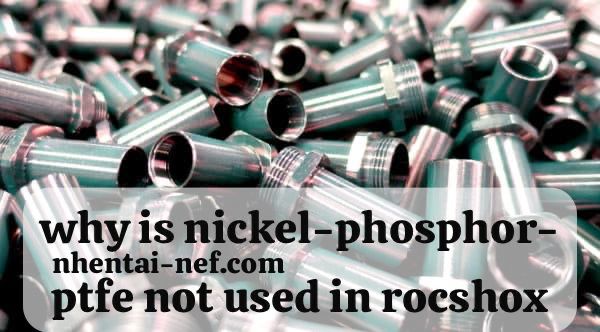
Understanding Nickel-Phosphor-PTFE: Why is Nickel-Phosphor-PTFE Not Used in RockShox?
What is Nickel-Phosphor-PTFE?
Nickel-Phosphor-PTFE is a composite material combining nickel, phosphor, and polytetrafluoroethylene (PTFE). This blend is engineered to provide superior performance in various industrial applications, especially where low friction and high wear resistance are essential. Nickel offers strength and durability, while phosphor contributes to the hardness of the coating. PTFE, commonly known as Teflon, enhances the material’s low-friction properties, making it an attractive choice for applications where reducing friction is crucial.
Properties and Benefits of Nickel-Phosphor-PTFE: why is nickel-phosphor-ptfe not used in rocshox? What You Need to Know
- Low Friction Nickel-Phosphor-PTFE excels in environments requiring low friction. The PTFE component minimizes resistance, enabling smoother operations in machinery and components. This property is particularly valued in applications like bearings and sliding parts, where reduced friction directly translates to lower energy consumption and improved efficiency.
- Corrosion Resistance The nickel and phosphor coating provides excellent corrosion resistance, allowing components to withstand harsh environmental conditions. This is crucial in applications exposed to moisture, chemicals, and other corrosive substances.
- Wear Resistance Nickel-Phosphor-PTFE is known for its wear resistance. The hardness imparted by phosphor enhances the longevity of components, making them less prone to degradation over time. This characteristic is essential in high-wear applications where maintaining performance is critical.
- Thermal Stability The composite material exhibits good thermal stability, allowing it to perform well in a range of temperatures. This ensures that components do not lose their properties under varying thermal conditions, which is essential in applications that experience heat fluctuations.
Applications of Nickel-Phosphor-PTFE: Why is Nickel-Phosphor-PTFE Not Used in RockShox?
Nickel-Phosphor-PTFE is employed across various industries, including automotive, aerospace, and manufacturing. It is often used in components like gears, valves, and pumps, where its unique properties can be fully utilized. However, despite its advantages, it has limitations that prevent its widespread adoption in specialized applications like those in RockShox products.
RockShox: A Brief Overview
Who is RockShox?
RockShox is a renowned brand in the cycling industry, known for its innovative suspension systems that enhance the performance and comfort of bicycles. Established in the late 1980s, RockShox revolutionized mountain biking with its pioneering suspension technology, allowing cyclists to tackle rough terrains with greater ease and control.
The Importance of Material Selection in RockShox Products: Why is Nickel-Phosphor-PTFE Not Used in RockShox?
Material selection is crucial in the design and manufacturing of RockShox products. The materials used must meet specific performance criteria, including strength, weight, and durability. Each component must function optimally under various riding conditions, including extreme temperatures, moisture, and mechanical stress. The wrong choice of material can lead to performance issues, compromising rider safety and enjoyment.
Performance Requirements for Suspension Systems: Why is Nickel-Phosphor-PTFE Not Used in RockShox?
- Impact Resistance Suspension systems must withstand significant impacts, especially in off-road riding. The materials used must absorb shocks and provide adequate support to the rider. Nickel-Phosphor-PTFE, while durable, may not possess the impact resistance required for high-performance suspension systems.
- Durability The longevity of components is paramount. RockShox products are expected to endure rigorous use over extended periods. Materials that wear down quickly can lead to frequent replacements and increased maintenance costs. Nickel-Phosphor-PTFE may not provide the same level of durability compared to other materials specifically designed for high-stress applications.
- Weight Considerations Weight is a critical factor in cycling performance. Lighter components enhance speed and maneuverability. While Nickel-Phosphor-PTFE is relatively lightweight, other alternatives may offer a better strength-to-weight ratio, making them more suitable for RockShox products.
- Compatibility Compatibility with existing materials and technologies is essential in suspension systems. The materials used must work seamlessly with other components to ensure optimal performance. Nickel-Phosphor-PTFE may not integrate well with the materials commonly used in RockShox products, leading to potential performance issues.
Why is Nickel-Phosphor-PTFE Not Used in RockShox?
1. Compatibility with RockShox Suspension Design
The design of RockShox suspension systems involves a careful balance of materials to achieve the desired performance. Nickel-Phosphor-PTFE’s properties may not align with the specific requirements of RockShox designs, leading to compatibility challenges. For instance, the expansion and contraction rates of different materials must be considered to prevent failure under stress.
2. Weight Considerations: Why is Nickel-Phosphor-PTFE Not Used in RockShox?
In high-performance biking, every gram counts. RockShox emphasizes lightweight materials to enhance rider performance. While Nickel-Phosphor-PTFE is not excessively heavy, alternatives like carbon fiber or specialized aluminum alloys may provide a better weight-to-strength ratio, making them more desirable in suspension systems.
3. Performance Limitations: Why is Nickel-Phosphor-PTFE Not Used in RockShox?
While Nickel-Phosphor-PTFE offers several benefits, it may fall short in performance under specific conditions. For example, its low friction properties may lead to insufficient grip or control in certain applications, which is counterproductive for a suspension system that relies on consistent performance and responsiveness.
4. Alternative Materials: Why is Nickel-Phosphor-PTFE Not Used in RockShox?
RockShox utilizes a range of advanced materials, including aluminum alloys and carbon fiber, known for their strength, lightweight properties, and durability. These materials are engineered to provide optimal performance in various riding conditions, making them a better fit for RockShox products compared to Nickel-Phosphor-PTFE.
5. Cost Considerations: Why is Nickel-Phosphor-PTFE Not Used in RockShox?
While cost may not be the primary consideration in high-end cycling components, it is still a factor. Nickel-Phosphor-PTFE can be more expensive to produce and apply compared to traditional materials used in RockShox products. The overall cost-effectiveness of materials plays a role in the final product pricing, influencing consumer choices.
6. Lubrication Requirements: Why is Nickel-Phosphor-PTFE Not Used in RockShox?
Lubrication is essential in maintaining the functionality of suspension systems. Nickel-Phosphor-PTFE, while low-friction, may require specific lubrication methods that complicate maintenance. RockShox designs its systems for ease of use and minimal maintenance, which may not align with the requirements of Nickel-Phosphor-PTFE.
7. Maintenance and Serviceability: Why is Nickel-Phosphor-PTFE Not Used in RockShox?
Ease of maintenance is a critical aspect of any biking component. Cyclists prefer products that are simple to service and repair. Nickel-Phosphor-PTFE may pose challenges in this area, as its unique properties might require specialized maintenance techniques that are not as straightforward as those for other materials used in RockShox.
Conclusion: Why is Nickel-Phosphor-PTFE Not Used in RockShox?
In summary, while Nickel-Phosphor-PTFE offers several beneficial properties, it does not meet the specific performance requirements and compatibility needs of RockShox products. The brand prioritizes materials that ensure durability, impact resistance, and lightweight design, which are essential for high-performance biking. Understanding why Nickel-Phosphor-PTFE is not used in RockShox provides insights into the complexities of material selection in the cycling industry and highlights the ongoing innovation in creating products that enhance the biking experience.





